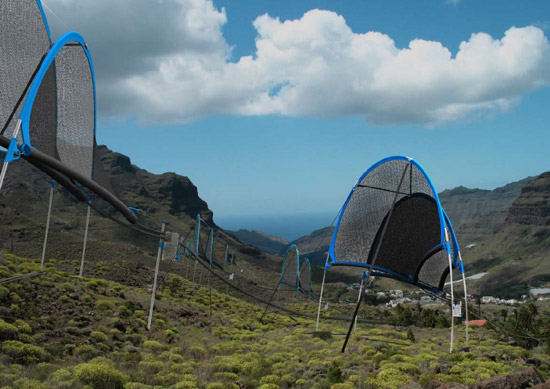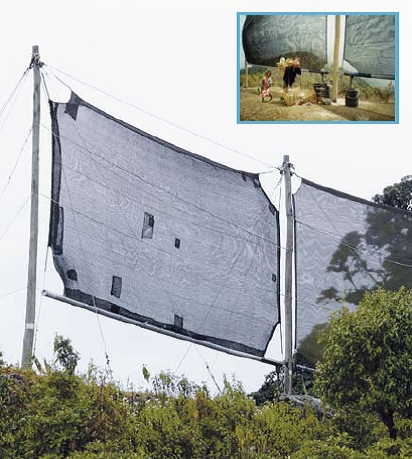Difference between revisions of "वाटर पोर्टल / वर्षाजल संचयन / कोहरा और ओस संग्रह / कोहरा जल संग्रह और भंडारण"
| Line 32: | Line 32: | ||
|} | |} | ||
| − | === | + | ===पर्यावरण में बदलाव को लेकर लचीलापन=== |
| − | + | समुद्र की सतह में बदलाव या मौसम के तापमान में बदलाव से बादलों की ऊंचाई प्रभावित हो सकती है. इसलिए यह सुनिश्चित किया जाना चाहिए कि कोहरे को एकत्रित करने वाली जाली उस स्थान पर एकदम बीचोंबीच लगी हो जहां धुंध सबसे अधिक होती है. अगर जलवायु परिवर्तन की वजह से बादलों का रुख बदलता है तो इन जालियों को हटाकर उस इलाके में ले जाना होगा जहां कोहरे का घनत्त्व सबसे ज्यादा हो. तटीय और ऊपरी इलाकों के वनों में तथा कटिबंधीय इलाकों में जहां कोहरा बहुत अधिक होता है वे सबसे अधिक प्रभावित होंगे. | |
| − | + | जब इस तरीके से संग्रहित जल का इस्तेमाल सिंचाई करने और इस तरह जंगलों में पौधरोपण बढ़ाने में किया जाता है तो तो इसे मरुस्थलीकरण की प्रकिया को कम किया जा सकता है. | |
===Construction, operation & maintenance=== | ===Construction, operation & maintenance=== | ||
Revision as of 18:52, 29 November 2015
| |
|
|
|
|
|
|
|
|
कोहरा जल संग्रह के लिए बड़े आकार की पोलीप्रोपलीन की जालियों का इस्तेमाल की जाती हैं जो पानी की बूंदों से भरे कोहरे को रोक कर पानी में बदलती हैं. पहाड़ी इलाकों और तटीय क्षेत्रों में आर्द मौसम में खूब कोहरा होता है. इन जालियों को हवा के सामने खड़ा किया जाता है. ये पानी की अत्यंत छोटी बूंदों तक को थामने में कामयाब होती हैं. यहां से ये बूंदें एक नालीनुमा आकृति के जरिए टैंक में पहुंचती हैं. वृक्ष और घास भी इसी तरह कोहरे को पानी में बदलते हैं.
आमतौर पर इस कोहरे की गुणवत्ता बहुत अच्छी होती है लेकिन इसके वायु प्रदूषण, छत की धूल या धातु की शीट पर लगी जंग आदि से प्रभावित होने की आशंका रहती है. अगर इन प्रदूषकों को थामने का उपाय किया जा सका तो यह पानी सीधे-सीधे या थोड़े बहुत उपचार के बाद पीने के लिए या अन्य घरेलू कामों में इस्तेमाल किया जा सकता है.
उपयुक्त स्थितियां
कोहरे या कहें धुंध का संग्रह उन स्थानों पर बहुत उपयुक्त होता है जहां अक्सर कोहरे जैसी स्थितियां बनती हैं. पहाड़ी इलाके जहां बादलों के चलते कोहरे की चादर छाई रहती है या जहां बादल पहाड़ों के ऊपर मंडराते रहते हैं. साथ ही अगर वहां हवा का बहवा 3 से 12 मीटर प्रति सेकंड के बीच हो और उसे कोई बाधा न हो तो यह और भी अच्छी बात है.
समुद्र की सतह पर उठने वाली धुंध या रात्रिकालीन विकरिण से पैदा होने वाली धुंध में आमतौर पर पर्याप्त पानी नहीं होता. इन जगहों पर हवा की गति भी इतनी नहीं होती कि पानी एकत्रित किया जा सके. मौसम विज्ञान विभाग के रिकॉर्ड और स्थानीय लोग इस बारे में जानकारी दे सकते हैं. ऐसी किसी भी जगह का चयन करते वक्त मौसम संबंधी और भौगोलिक विचार बहुत मायने रखते हैं. उदाहरण के लिए हवा के बहाव की दिशा, एक निश्चित ऊंचाई पर बादलों का बनना, धुंध से पानी एकत्रित करने वालों के लिए पर्याप्त जगह और किसी किस्म की बाधा का न होना आवश्यक है. तटवर्ती इलाकों की बात करें तो वहां तट से 5-10 किमी के दायरे में पहाड़ होने चाहिए.
अगर पर्याप्त पानी संग्रहित किया जा सका तो वहां पौधरोपण भी किया जा सकता है और फसल भी बोई जा सकती है. एक बार अगर पौधरोपण में सफलता मिल गई तो फिर वे पौधे खुद धुंध की बूंदों को ग्रहण कर सकते हैं.
| लाभ | हानि |
|---|---|
| - परियोजना लागत कम - साधारण तकनीक और देखरेख |
- इस तरीके से अपेक्षाकृत कम पानी जुटाया जा सकता है. - पोलीप्रोपलीन कुछ जगहों पर आसानी से नहीं मिलती. |
पर्यावरण में बदलाव को लेकर लचीलापन
समुद्र की सतह में बदलाव या मौसम के तापमान में बदलाव से बादलों की ऊंचाई प्रभावित हो सकती है. इसलिए यह सुनिश्चित किया जाना चाहिए कि कोहरे को एकत्रित करने वाली जाली उस स्थान पर एकदम बीचोंबीच लगी हो जहां धुंध सबसे अधिक होती है. अगर जलवायु परिवर्तन की वजह से बादलों का रुख बदलता है तो इन जालियों को हटाकर उस इलाके में ले जाना होगा जहां कोहरे का घनत्त्व सबसे ज्यादा हो. तटीय और ऊपरी इलाकों के वनों में तथा कटिबंधीय इलाकों में जहां कोहरा बहुत अधिक होता है वे सबसे अधिक प्रभावित होंगे.
जब इस तरीके से संग्रहित जल का इस्तेमाल सिंचाई करने और इस तरह जंगलों में पौधरोपण बढ़ाने में किया जाता है तो तो इसे मरुस्थलीकरण की प्रकिया को कम किया जा सकता है.
Construction, operation & maintenance

Once a polypropylene net is obtained, use it correctly in a double layer. This is normally either polypropylene or polyethylene, u/v protected, with 35% shade coefficient, Raschel mesh weave, and a 1mm fibre size. Efficiency increases with smaller mesh sizes and fibre width.
Net area needs to be large enough to collect the required amount of water. Typical dimensions per net might be 12m long x 4m high (48m2). Typical collection rates vary according to the site but seem to average out at anywhere between 2 litres up to 5 litres per m2 per day, with maximums up to 10 litres per m2 per day.
Space the nets at 5 metre intervals along the contour (horizontally) and at a distance equal or greater to 60 times the fog collector height in an uphill/downhill direction. This allows for the most efficient collection of fog. It also means that wind damage is less likely compared with collectors that are joined together. In general, these flat units are good for wind speeds up to 20m/s. Cables should be protected within garden hose to prevent them causing erosion of the structure.
Typical water production rates from a fog collector range from 150 to 750 litres per day but some schemes are capable of producing 2,000 to 5,000 litres per day. Efficiency of collection improves with larger fog droplets, higher wind speeds, and narrower collection fibers / mesh width. In addition, the mesh should have good drainage characteristics. In high winds, nets would normally be taken down as part of normal operation and maintenance.
Maintenance
A polypropylene mesh has a lifetime of about ten years. In Nepal, operation and maintenance is difficult due to the unavailability of spare parts (mainly polypropylene mesh). Hence keeping stock of mesh and other spare parts is highly recommended. In high winds, nets would normally be taken down as part of normal operation and maintenance. Otherwise where fog collectors are remotely located, different designs are being researched which may provide increased robustness.
Costs
The costs vary depending on the size of the fog catchers, quality of and access to the materials, labour, and location of the site. Small fog collectors cost between US$75 and US$200 each to build. Large 40-m² fog collectors cost between US$1,000 and US$1,500 and can last for up to ten years. A village project producing about 2,000 litres of water per day will cost about US$15,000 (FogQuest, 2011). Multiple-unit systems have the advantage of a lower cost per unit of water produced, and the number of panels in use can be changed as climatic conditions and demand for water vary (UNEP, 1997). Community participation will help to reduce the labour cost of building the fog harvesting system.
- Material: Polypropylene mesh per 1 m2 (Peru and Chile): US$ 0.25
- Labour: construction and installation of large fog collectors, reservoir tanks and taps:
- Skilled labour: 140 man days (Nepal): US$4 per day
- Unskilled labour: 400 man days (Nepal): US$2.75 per day
- All inclusive (materials, labour):
- Fog collectors including building materials: US$100 - 200
- 48 m2 fog collector providing 3 l/m2/day: US$378
- Cost per m2 (Nepal, including reservoir and tap): US$60
Field experiences
According to the International Development Research Centre (1995), in addition to Chile, Peru, and Ecuador, the areas with the most potential to benefit include the Atlantic coast of southern Africa (Angola, Namibia), South Africa, Cape Verde, China, Eastern Yemen, Oman, Mexico, Kenya, and Sri Lanka.
Fog water collection is used in Nepal, Peru, Chile, etc.
The largest site in Guatemala produces 7,000 litres per day during the dry season. In Nepal, cost per m2 was $60, which included all materials for nets and reservoirs, plus labour.
Manuals, videos, and links
- FogQuest
- NEWAH information on fog water collection. Nepal Water for Health (NEWAH) homepage.
- Tapping into Fog, IDRC. International Development Research Centre (IDRC) homepage
- Fogwater Harvesting for Community Water Supply MSc Thesis, Cranfield University
- The Environment Canada Handbook on Fog and Fog Forecasting Environment Canada.
Acknowledgments
- CARE Nederland, Desk Study: Resilient WASH systems in drought-prone areas. October 2010.
- Smart Water Harvesting Solutions: Examples of innovative, low cost technologies for rain, fog, and runoff water and groundwater. (or alternative link) Netherlands Water Partnership, Aqua for All, Agromisa, et al. 2007.
- Schemenauer, Robert and Cereceda, Pilar. Tiempo: Fog Collection
- Technologies for Climate Change Adaptation: Agricultural Sector. UNEP. August 2011.

